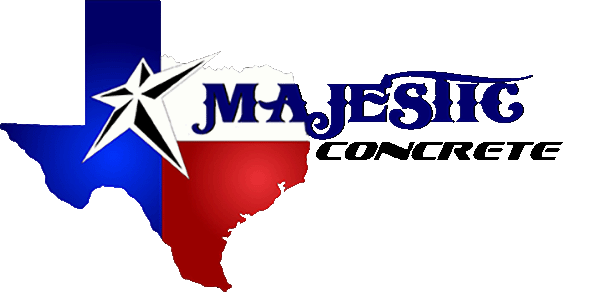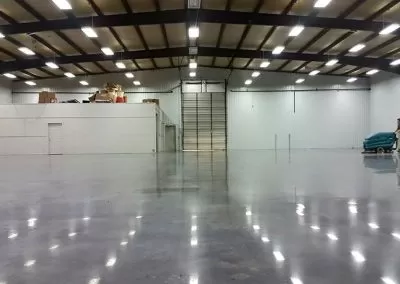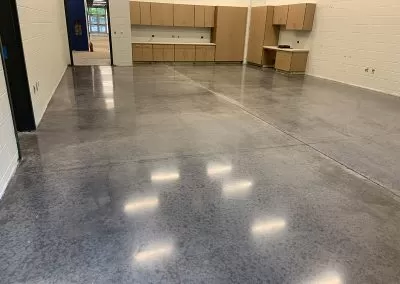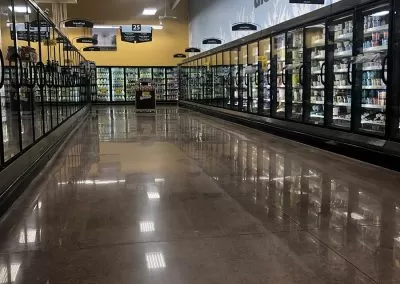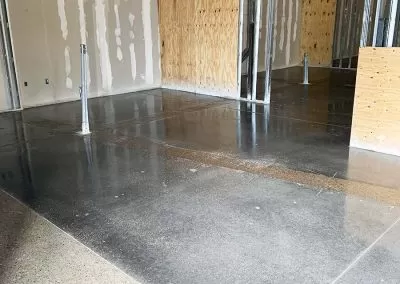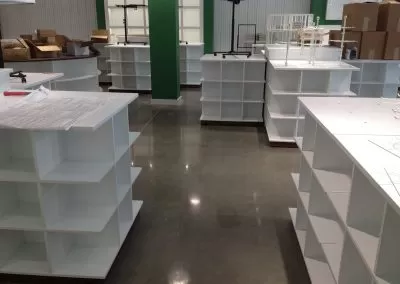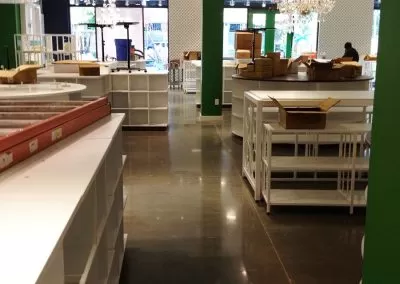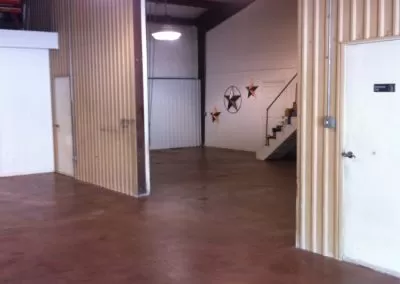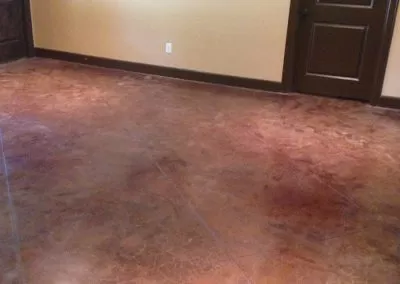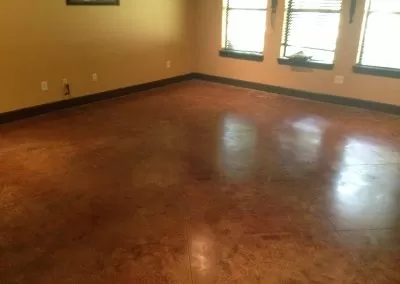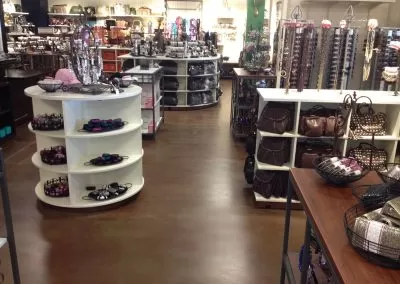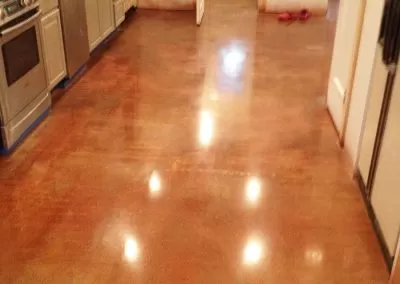Polished Concrete
Are you looking to transform your concrete
Concrete Polishing is the process of utilizing industrial diamonds to grind and polish a concrete surface with the application of a impregnating hardeners and sealers that will densify, polish and seal the floor.
1. Process may be either a proprietary system from specialty contractor or
use of specified products with acceptable grinding methods.
2. Acceptable Grinding Methods: Equipment and techniques that produce
documented results of concrete finishes.
The Grind and Polish Process
In the quest to develop the polished concrete standard, the International Polished Concrete Institute states not just a definition, but also a methodology clarification for polished concrete. “Polished concrete is a process which enhances the natural beauty of existing concrete by hardening and applying a sheen to the concrete. There are two primary methods to create this sheen: Topical or Mechanical.” While both methods will provide a sealed floor, mechanical polished concrete is preferred in most applications due to its extended longevity, low maintenance, sustainability, and stunning esthetic. Just as every slab of marble or granite is unique, each polished concrete floor contains its own characteristics. This stone-like, mottled appearance is very appealing, and adds character to the floor.
Topical Polishing
A Topical Polish is a product treatment rolled or sprayed onto the surface of the concrete to seal it. Examples of this are wax coatings and buffed hardeners. If a higher sheen is preferred, many applications require a buffing or burnishing step to create a shine. While the concrete will have a coated, sealed appearance, the concrete will retain its coarse texture, and any inconsistencies in the surface will remain visible.
Sheen Level/Finish Options
* Topical-Sheen Level 1: Matte finish: Scrub and Seal
* Topical-Sheen Level 2: Low Sheen: Scrub, Buff, and Seal
* Topical-Sheen Level 3: High Sheen: 4-Step Resin Polish
Mechanical Polish
A mechanical grinding & polishing process that utilizes industrial diamonds & impregnating hardeners and sealers to level, densify, polish & finally seal the floor from within the interior of the floor surface.
* Wet Polish: Extends the life of diamond tooling by using water to cool, however, creates a slurry which much be disposed of.
* Dry Polish: A preferred polishing method as it does not create a slurry, and can be performed with no production down time.
Sheen Level/Finish Options
* Level 1: Matte Finish: 100 grit
* Level 2: Low Sheen: 400 grit
* Level 3: High Sheen: 800 grit
* Level 4: Gloss Shine: 3000 grit
Benefits of Polished Concrete
- Elimination of Dusting from Efflorescence
- In ordinary unpolished concrete, tiny particles of dust are pushed to the surface through an upward force called hydrostatic pressure, resulting in efflorescene. Efflorescene leads to dusting, which forces epoxies off of the surface of concrete floors, and can make maintenance a costly priority.
- Stain-Resistant
- By densifying and sealing the surface, polished concrete transforms a porous concrete floor into a tightened floor that is dense enough to repel water, oil, and other contaminants, preventing them from penetrating the surface.
- Improved Reflectivity and Ambient Lighting
- The reflective properties of a polished concrete floor increases the lighting in facilities. Increased ambient lighting will reduce the energy bill as well as look beautiful.
- Increased Slip Resistance
- Polished concrete, though quite shiny, does not create a slippery floor. In fact, the benefits of mechanically grinding and flattening the floor will increase the coefficient of friction when compared to ordinary concrete. Polished concrete often exceeds OSHA standards for floors. (ASTM C 1028)
- Less Maintenance
- Most floor systems, including tile and linoleum, require aggressive scrubbing to maintain a clean environment and nice appearance. Polished concrete surfaces are tightly compacted, reducing stains, and do not require any waxing or stripping to maintain the sheen.
- Cost-Effective
- Polished concrete will reduce energy and maintenance costs significantly through reflectivity and ambient lighting, reduction in upkeep (such as waxing), and reduced tire wear.
- As concrete ages, surface stress, delamination, curled cold joints, and other problems can arise. Mechanically grinding the floor will remove the top surface of the old concrete and polishing will then strengthen it, increasing it’s impact and abrasion resistance.
- The rough, uneven texture of natural concrete causes tires to abrade, adding to their wear. A polished concrete floor system will level the joints and make the entire surface smooth, preventing this abrasion.
- Dry-Mechanically polished concrete can be put into service immediately after the process is complete. Due to the cleanliness of the process and the lack of toxic or hazardous chemicals, floors can often be serviced while the plant is in full production.
FAQ's
DO YOU PROVIDE FREE ESTIMATES?
Yes we do! During the estimating stage, it is a great time for us to find out your needs and present the best options to fulfill them.
IS DECORATIVE CONCRETE ONLY FOR NEW CONSTRUCTION PROJECTS?
No! In fact many of projects are renovations that will leave you with a brand new beautiful floor.
WHEN IS THE BEST TIME TO BEGIN MY NEW CONSTRUCTION FLOORS WITH MAJESTIC CONCRETE?
For new construction projects, we begin after the building is dried in, but before spray insulation or drywall. There are times when we have exceptions to this rule; i.e. , scheduling conflicts, contractor commitments, etc.
WHAT HAPPENS ONCE MAJESTIC CONCRETE BEGINS MY PROJECT?
Once we begin the process of cleaning and prep, it is IMPORTANT that nobody except our crew have access to the area. If this area is a high traffic area, it is sometimes better to find a temporary living arrangements until the project is complete.Once the project is sealed and dry, the project is turned back over to the customer for full access.
FOR A RENOVATION, WHAT DO I NEED TO DO?
Before we arrive the customer must make sure the area is cleared of anything on the floor, i.e. furniture, boxes, plants, etc. For interior project the baseboards should be removed, or at a minimum the shoe moulding should be removed so that we are able to get as close to the walls as possible.
WHAT ABOUT ANY CONSTRUCTION MODIFICATIONS LIKE TRANSITION STRIPS AND MOULDINGS?
Majestic Concrete is not responsible for anything construction wise besides the flooring. We do not take care of baseboards, shoe moulding, transition strips, painting, paint touchup, etc. This should all be handled by the homeowner before and/or after we are complete.
HOW LONG DOES IT TAKE TO INSTALL?
On average it takes 2-3 days for most jobs but the size and scope of the job can addadditional days.
Get a Free consultation and estimate today
Let's discuss your next decorative concrete project!
Contact Us Today
Follow Us
Contact Hours
M-F: 8am - 5pm
Sat-Sun: Closed
